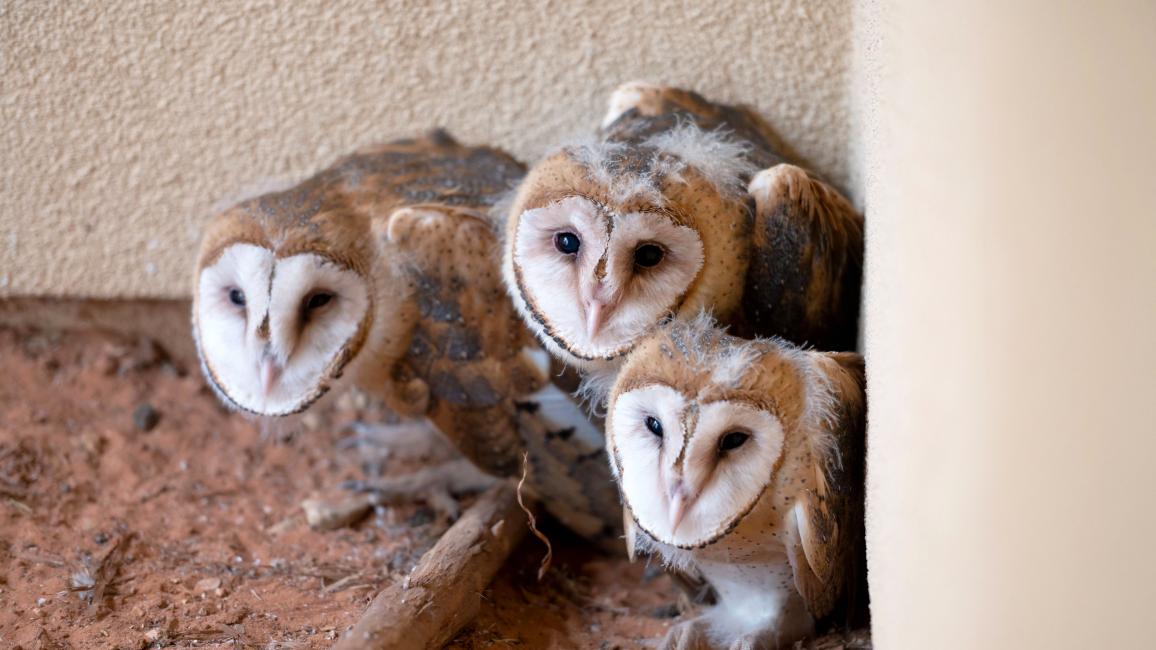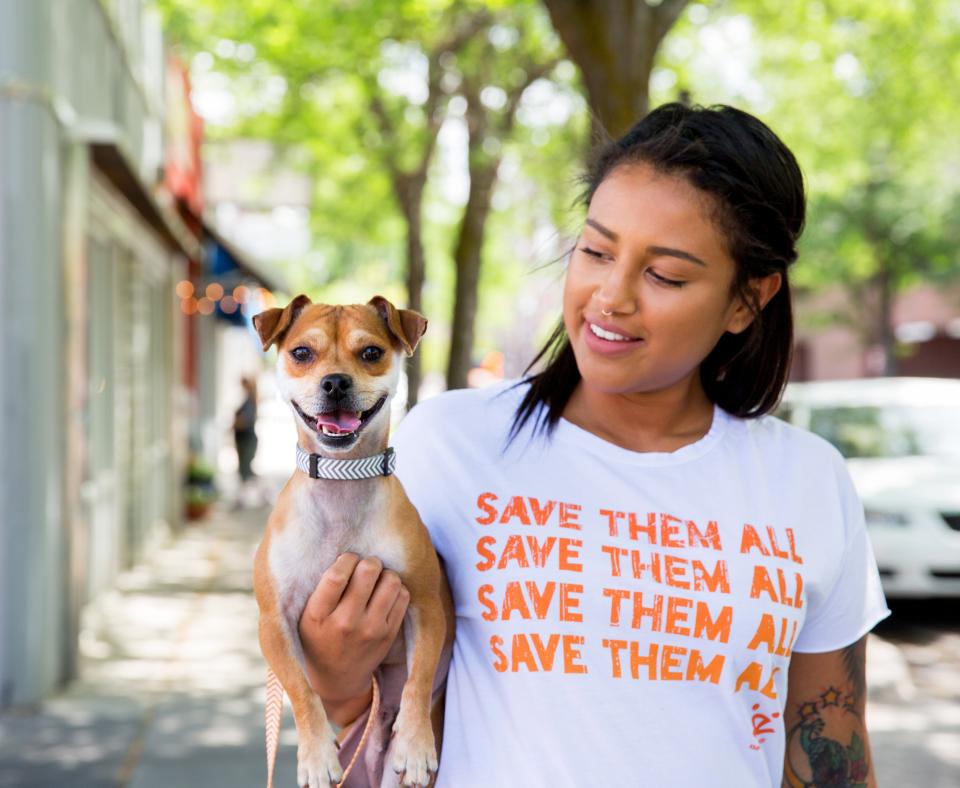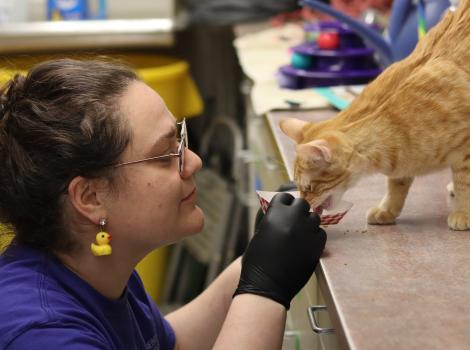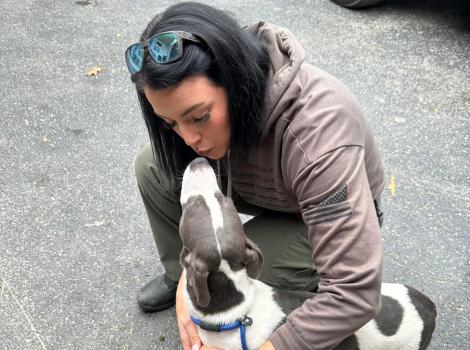Bringing up orphaned barn owls

“I have three baby owls without their mother. I’m worried that they may fly off.” This was a call Wild Friends — the state and federally licensed wildlife rehabilitation area of Best Friends Animal Sanctuary — received from Al, who sells hay. He already knew about Wild Friends, having called two years before about other orphaned young birds.
So Corinne Blossfeld, licensed wildlife rehabilitator at Best Friends, drove to Big Water, Utah, to pick up the owls.
Corinne arrived in Big Water and went out into the field where she could see Al’s open truck from which he was selling hay. She climbed up into the bed of the truck and found not just three, but six little nestling owls, all clustered together in a space between the hay bundles. Al had been pulling out the hay to sell it when he came across them. Earlier that morning, without realizing that the baby owls were in his truck, he had driven to Big Water from Holden, Utah, and unfortunately the owl parents must have flown away. The nestlings were too young to fly.
Barn owl nestlings have a big scream
As soon as the nestlings spotted Corinne, they knew in an instant that she definitely was not their mom. Instead of realizing that they were being rescued, they were mad and began to scream. Anyone who has ever heard the sound that an adult barn owl makes will never forget it — it is a gigantic scream. The babies’ screams were not quite as enormous as that, but it was still loud enough.
All six nestling owls lay flat on their backs with their feet out in the air, screaming with all their might — completely unaware that someone was helping them. Corinne carefully picked up each one and placed all six of the babies into a soft-sided carrier, so they could travel safely.
[Barn owls rescued, nest and all, from accidental road trip]
On the way back, to ensure a gentle ride for the babies, she played no music and kept the car at an even temperature. The drive back took around 90 minutes. At every bump in the road, the babies screamed again. In a way, this was good; it meant that they were healthy and energetic enough to scream. Sometimes, they calmed down, but then if they hit an unexpected turn, there was renewed screaming all over again.
A horrendous scream is really the hallmark of an adult barn owl, and they were behaving true to the nature of their species.
As soon as they all arrived safely at Best Friends, they were put into a quarantine room with a heating pad — still screaming a healthy, energetic scream.
Feeding barn owls
Bradley Kay, Wild Friends lifesaving and care supervisor, was there to help. She and Corinne got ready to feed the baby owls. First, they donned gowns and gloves to protect the babies from any germs while they were being weighed. Then they put on ghillie suits, designed to make them look just like natural shrubs. Wildlife patients shouldn’t get used to looking at humans. After they had all been weighed, they settled down for a while — peaceful at last.
Later that night, Corinne came back to feed them, making sure that each one got some food. After two or three days, they were able to start eating by themselves. All were tested to be sure that they didn’t have avian influenza. After four or five days, the results came back negative.
Remembering that they are owls
Now, being a bit bigger, the baby owls are better able to regulate their own body temperature. They have a heater too just to be sure they don’t get cold. They’re eating well — once a day — and they’re doing great overall.
They are left alone with just each other’s company. One of the most important things that licensed wildlife rehabilitators do is to make sure that the wild animals in their care do not ever become tame. Becoming habituated to people would jeopardize their ability to survive in the wild after they’re released. It would make it quite hard for them to relate to other owls and lead a normal owl’s life.
So great care is taken to ensure that they stay wild and do not become used to people. They need to know that they are owls. Almost fully feathered now, soon the owls will go into an aviary to get used to being outside and practice flying.
More owl babies
The first owl nestlings had been at the Sanctuary just four days when Wild Friends received a call from a friend of Al’s, who had found even more baby owls.
The second man also sold hay with the same company, and he’d been working near the same farm in Holden. Having driven from Holden to Big Water to sell hay, when he arrived he discovered three baby owls among the hay in the back of his truck. He called Wild Friends to report: “I’ve got three baby owls.”
Lauren Ross, subpermittee and Best Friends lifesaving and care specialist, drove to Big Water to get them and took special care to keep the owls warm on the drive back. These three were quite a bit smaller than the first six, and they were covered in white down with no actual feathers yet. Though all three were from the same nest, they were different sizes, one bigger than the others.
As is required, the new nestlings were all tested for avian flu, and they were fine.
For the moment, the three new baby barn owls are being fed four times a day. Corinne and Lauren wear ghillie masks while feeding them, and they have with them a little puppet that looks like a barn owl.
Soon, the babies will start getting in their feathers, and with feathers they’ll be better able to regulate their temperature and won’t need much additional heating. Two of the original six babies will be kept back to help teach the younger ones how to fly once they’re ready for the aviary. Then, they’ll be nearly ready for release.
They’ll most likely be released near Holden, Utah, which was their original home. Soon, these barn owl babies at Wild Friends will have a happy future back in the wild, living free again in the beauty of the natural world.






